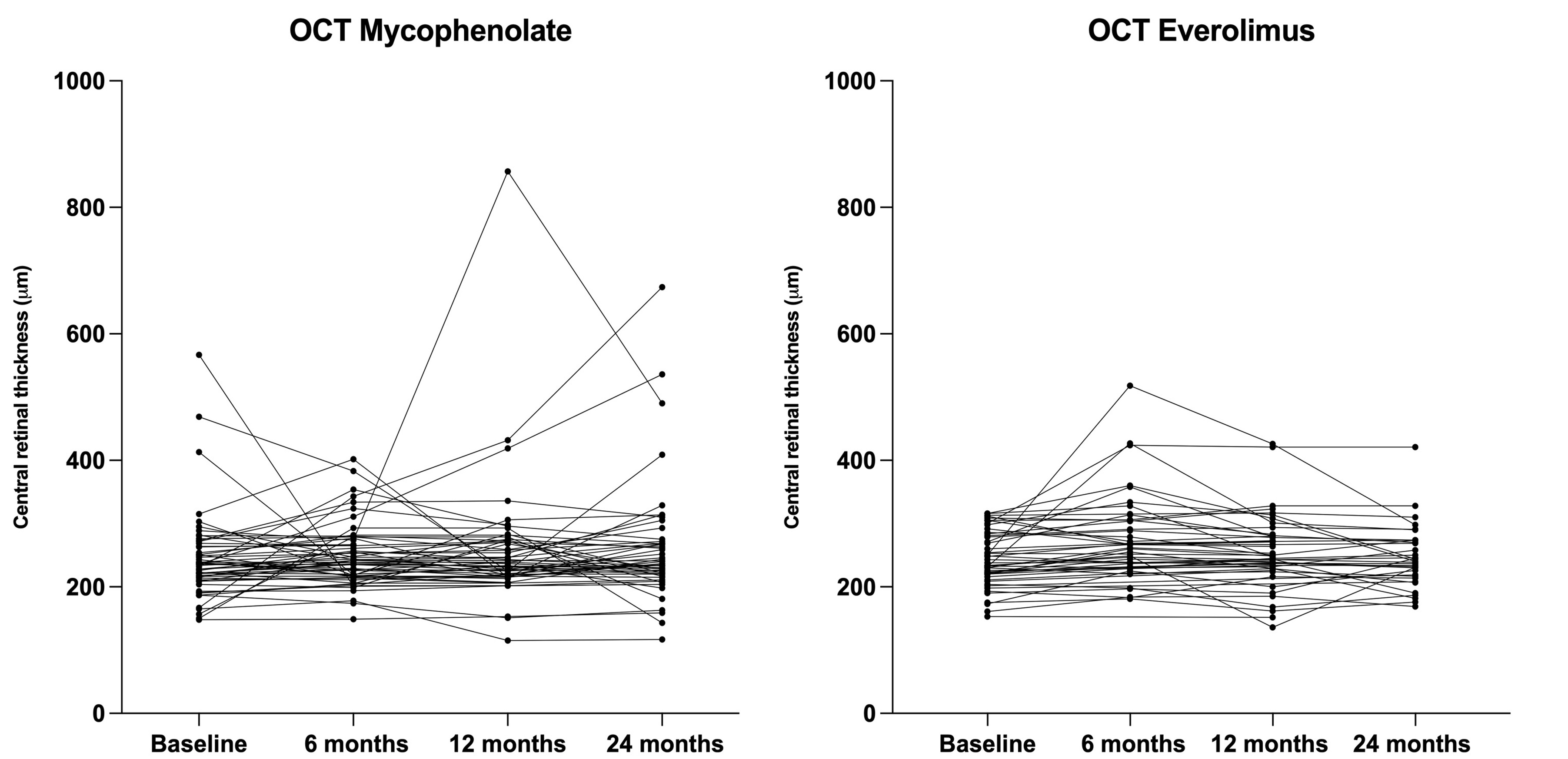Everolimus versus Mycophenolate in Simultaneous Pancreas and Kidney Transplantation: Progression of Diabetic Retinopathy in a Prospective Randomized Trial
B. Hagerf1, Z. Hladíková1, M. Zahradnická1, K. Kesslerová2, T. Sosna2, P. Girman1, F. Saudek1
1Diabetes Centre, IKEM, Prague, Czech Republic, 2Ophtalmology Clinic, Thomayer Hospital, Prague, Czech Republic
Meeting: 2022 American Transplant Congress
Abstract number: 1173
Keywords: Hyperglycemia, Immunosuppression, Kidney/pancreas transplantation, Metabolic disease
Topic: Clinical Science » Pancreas » 65 - Pancreas and Islet: All Topics
Session Information
Session Name: Pancreas and Islet: All Topics
Session Type: Poster Abstract
Date: Sunday, June 5, 2022
Session Time: 7:00pm-8:00pm
 Presentation Time: 7:00pm-8:00pm
Presentation Time: 7:00pm-8:00pm
Location: Hynes Halls C & D
*Purpose: mTOR inhibitors are known for their antiangiogenic effect. We compared the impact of everolimus (E) and mycophenolic acid (MPA) on the course of diabetic retinopathy (DR) in a prospective randomized trial in pancreas and kidney transplant recipients; EUDRACT No.2013-004934-14.
*Methods: Waitlisted Type-1 diabetic subjects were randomized to treatment with MPA or E together with tacrolimus, 6 weeks steroids and ATG induction. Eye examination including optical coherence tomography (OCT) was done at the baseline, 6, 12 and 24 months. The composite primary endpoint comprised new need for laser therapy, newly diagnosed proliferation, clinically significant macular edema (CSME), best corrected visual acuity (BCVA) worsening. For statistical evaluation we used t-test, Mann-Whitney test, Fisher’s test, Kaplan-Meier test and log-rank test. Endpoints were evaluated per patient and per eye.
*Results: Out of 64 enrolled patients, 55 (MPA 29, E 26) completed the follow-up. Most of these had proliferative DR (MPA 82.4% eyes, E 78.2% eyes) with previous laser treatment. 2-year patient and death-censored graft survival rates did not differ between the groups. 59% of the patients in the MPA group and 50% in E group met the primary endpoint (p=0.6), mostly due to new proliferation, need for laser treatment and BCVA worsening. When analyzed per eye, the need for laser therapy was more frequent in the MPA group, reaching statistical significance in the second year post-transplant (22.8% vs 5.8%, p=0.015), which corresponded with BCVA worsening (33.3% and 15.7%, p=0.045). Retinopathy-related BCVA worsening rate was significantly higher in the MPA than E group (22.8% vs 5.8%, p=0.015). Total occurrence of bleeding was 19.3% in MPA vs 3.9% in the E group (p=0.0154). There was no case of new blindness. Central retinal thickness increased in the 6th month post-transplant in both groups with subsequent restoration at 12 months. CSME rate was almost identical in both groups (MPA 7%, E 7.8%, p=0.9). Patients treated with laser less than 12 months pre-transplant were more likely to suffer from further DR progression meeting the primary endpoint in 72.7% (MPA) and 66.7% (E).
*Conclusions: We demonstrated more favorable course of diabetic retinopathy in treated with everolimus subjects in a prospective randomized trial.
Supported by Czech Ministry of Education – grant LTAUSA19073 and by MH CZ – DRO Institute for Clinical and Experimental Medicine – IKEM, IN 00023001
To cite this abstract in AMA style:
Hagerf B, Hladíková Z, Zahradnická M, Kesslerová K, Sosna T, Girman P, Saudek F. Everolimus versus Mycophenolate in Simultaneous Pancreas and Kidney Transplantation: Progression of Diabetic Retinopathy in a Prospective Randomized Trial [abstract]. Am J Transplant. 2022; 22 (suppl 3). https://atcmeetingabstracts.com/abstract/everolimus-versus-mycophenolate-in-simultaneous-pancreas-and-kidney-transplantation-progression-of-diabetic-retinopathy-in-a-prospective-randomized-trial/. Accessed December 22, 2025.« Back to 2022 American Transplant Congress

